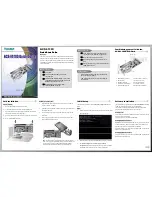
Chapter 3
Hardware Overview
3-4
ni.com
Acquisition and Region-of-Interest (ROI) Control
The acquisition and region-of-interest control circuitry routes the active
pixels from the 10-bit ADC to the onboard memory. The PCI/PXI-1409 can
perform ROI and scaling on all video lines. Pixel and line scaling transfers
certain multiples (two, four, or eight) of pixels and lines to onboard
memory.
RTSI Bus
The seven trigger lines on the RTSI bus provide a flexible interconnection
scheme between multiple PCI/PXI-1409 boards as well as between any
National Instruments DAQ or Motion device and the PCI/PXI-1409.
Digital Input/Output Circuitry
The digital input/output circuitry routes, monitors, and drives the external
trigger lines, RTSI bus lines, and camera control lines. You can use the
trigger lines to start or stop an acquisition on a rising or falling edge.
In addition, you can map onboard signals such as HSYNC, VSYNC,
ACQUISTION_IN_PROGRESS, and ACQUISITION_DONE to these
lines. The camera control lines provide a means to generate deterministic
signals for triggering cameras, strobe lights, or other timing-critical
applications. This module also contains an external clock generation
circuit. You can use this external clock as the source clock for a line scan
camera.
Acquisition Modes
The 1409 device supports five video acquisition modes.
•
Standard Mode—In standard mode, the 1409 device receives an
incoming composite video signal from the external BNC or 68-pin
VHDCI connector and generates CSYNC, HSYNC, VSYNC, and
PCLK signals. The generated CSYNC signal is output on the VHDCI
connector to synchronize other image acquisition boards or cameras.
•
CSYNC External Mode—In CYSNC external mode, the 1409 device
receives an incoming video signal (composite or luminance) and an
external CSYNC signal from the external connector and generates
HSYNC, VSYNC, and PCLK signals.
















































